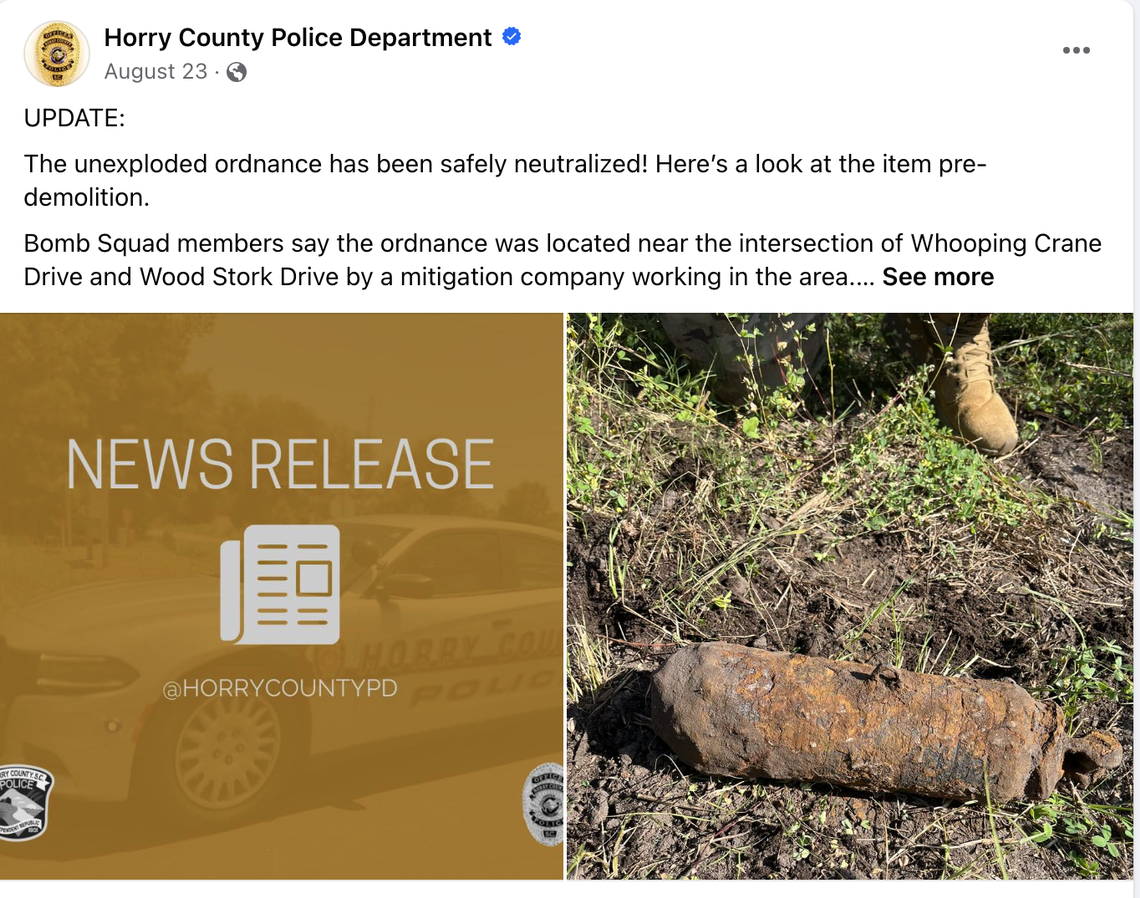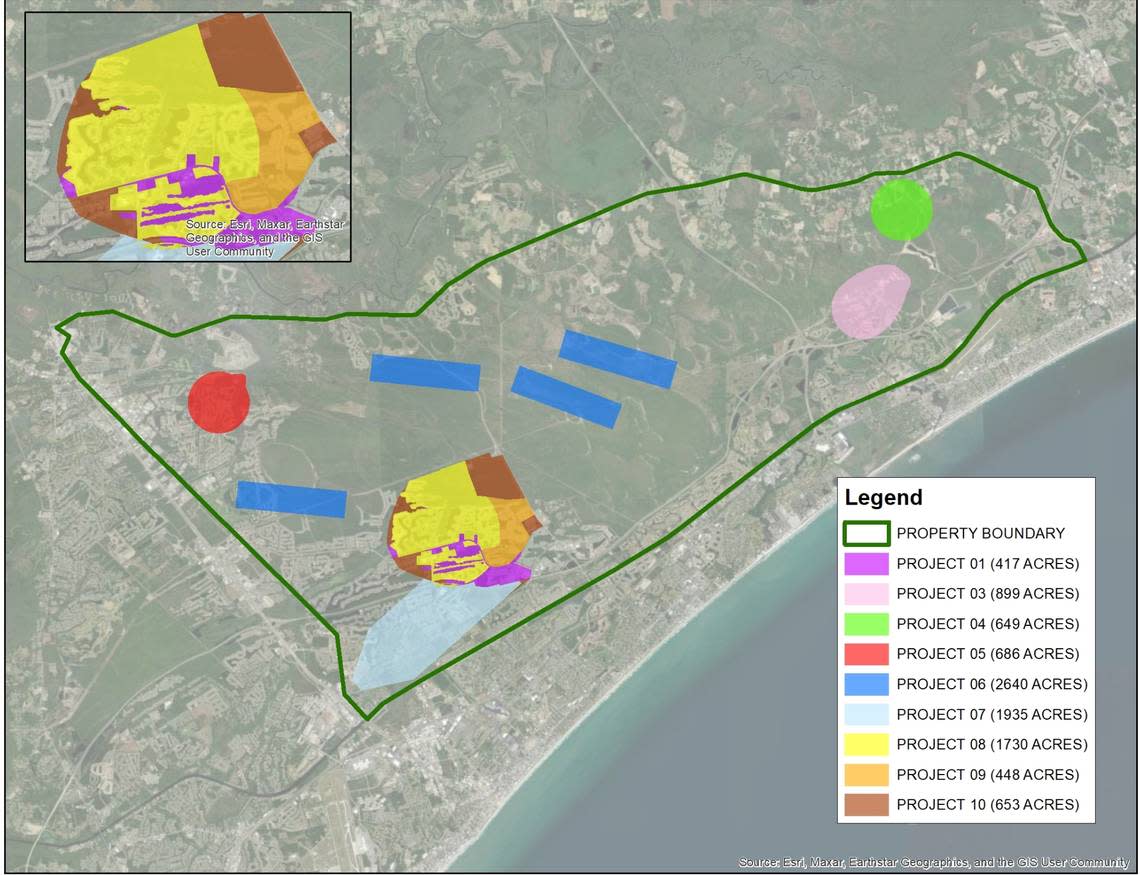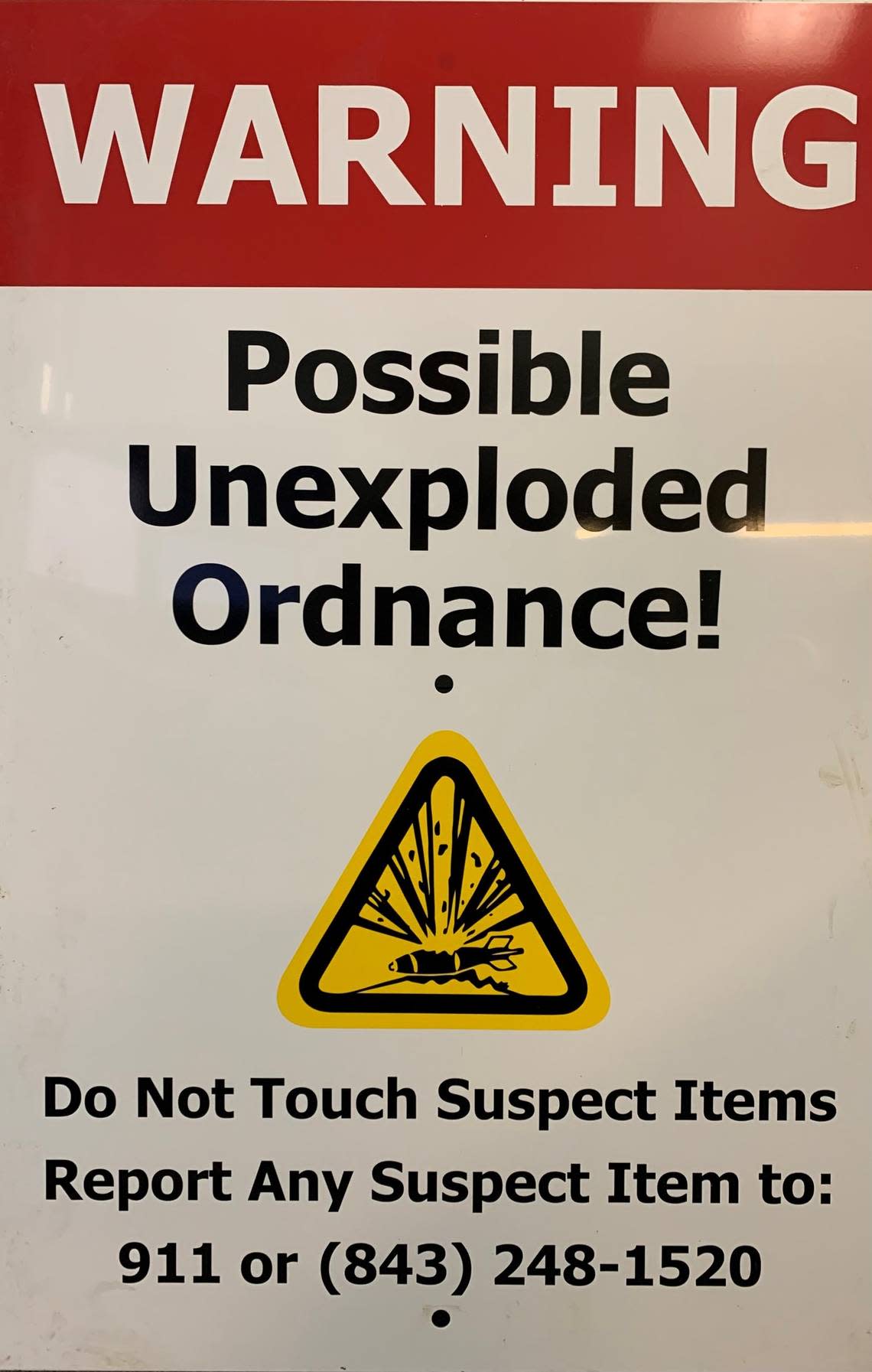Is your Myrtle Beach area home built atop or near an ‘unexploded bomb’? Here’s the map.
Editor’s note: What Myrtle Beach people, places or things make you nostalgic? Tell us more about this story or other notable stories that our journalists should know about our community. Email us at online@thesunnews.com.
If you live near the Carolina Forest area, there’s a good chance your home could have been built atop a WWII era bombing range. Those rusty old explosives are still being found over 70 years later.
In August of this year the Horry County Police department warned on their Facebook page that they were preparing to detonate a unexploded ordnance in the Carolina Forest area. The corroded, cylindrical shaped objects shown in the photo had likely been lying beneath the surface since the 1940s. The HCPD Bomb Squad and the U.S. Air Force EOD from Shaw Air Force Base safely disposed of the ordnance according to their post.
Thousands of similar munitions have been found in the area in the decades since it was a designated bombing and gunnery range by the U.S. Army Air Corps.

Some of Horry’s fastest-growing areas sit atop the WWII bombing range
Between 1942 and 1947 the Conway Bombing and Gunnery Range, BGR, was the target of air crews dropping bombs, firing rockets, and making strafing runs over what was then thousands of acres of woodlands. Machine gun and artillery ranges were also used for live fire practice in the area.
The Conway BGR consists of 55,854 acres stretching from U.S. 501 Western boundary to Route 9 on the East and is bordered by S.C. 90 on the North and the Intracoastal Waterway to the South. The range is about 13 miles long and 5 miles wide including much of the Carolina Forest area and the Highway 90 corridor.
Those dummy bombs and rockets, primarily filled with sand and cement, caused little concern for decades as they sat undisturbed in the pine forests and bay of undeveloped Horry County. But as new development sprang up so did the risks of someone stumbling across the unexploded ordnance left behind.

Close encounters with unexploded ordnance have been documented through the years
Stories in The Sun News have highlighted the issue through the years.
A headline from a 2005 article perhaps describes the situation best: ‘Carolina Forest residents vexed by WWII Bombs,’ and describes how bombs and munition fragments were found off Carolina Forest Boulevard while clearing the site for the Amazing Grace Lutheran Church and how the unexploded ordnance continues to be a problem for planners and developers.
In 2008 plans for a county park were stalled due to safety concerns and the park was eventually relocated to its current International Drive location.
A 2018 a headline warns: ‘More explosions likely in Carolina Forest’ after over a dozen pieces of ordnance were found as land was being cleared for The Park at Carolina Forest subdivision. Another story from the following week describes how an old mortar shell was discovered as a patio was being built for a home off Waterway Drive in North Myrtle Beach.
Those stories represent only a small sample of the thousands of munitions and remnants of WWII era munitions were found in the former bombing range.

How great of a hazard do these unexploded ordnance present?
According to Ray Livermore, an environmental engineer with the U.S. Army Corps of Engineers tasked with helping to research and remediate the risks, the largest percentage of the “Munitions or Explosives of Concern” (MECs) were practice bombs that were either filled with concrete or sand but they did often have an explosive black power “spotting charge” on them “similar to like a shotgun shell” which could result in injury.
The greater concern, he says, is that there have been high explosives found in the past.
“My understanding is that a lot of these were discovered back when the initial development was happening,” but he said he could not discount the fact that there could be more there.
“So obviously the primarily associated risk is injury, limb loss and then obviously fatality, which of course we don’t want anything like that to occur at these sites,” he said.
Where are we with the clean-up?
For decades the U.S. Army Corps of Engineers, USACE, as part of the Department of Defense’s Former Used Defense Sites program, has been working to identify potential risks and clean up the area. But, in the Myrtle Beach area growth and development has far outpaced the Federal Government’s response. Horry County Council wrestled for years over what to do about the potentially contaminated areas.
In 2002, the council ruled that property owners acknowledge when they developed on sites located in the former bombing and gunnery ranges, according to news reports from that time. As a result, development groups have often had to hire specialists to identify and remove munitions from the contaminated sites before building on the land.
Livermore explains that ten ongoing “projects” correspond to specific ranges that comprise the larger Conway BGR. The FUDs program is essentially a two-part process consisting of a “characterization” or investigation phase, where the Corps identifies the possible environmental hazards at each site and recommends ways to remedy the issue.
The second and final part of the process is the “remediation phase.” Remediation can range from physically removing munitions where necessary to providing public education in those areas that are considered lower risks.
According to Livermore, the bulk of the Corps work has been in that first “characterization”phase. “Sometimes it can be kind of frustrating because of the timeline and the length of the characterization to get to the end phase,” he acknowledges.
More to be done to remedy the remaining target areas
However, of the ten projects, only four still require action. The rest of the ranges have either been deemed safe enough that “no further action” is recommended or have been settled or cleared by private landholders. The Corps list the current status of each of their Conway BGR projects:
Project 01, Range III: Proposed Plan and public meeting planned for early 2024. Record of Decision to be approve in 2024. Award contract to implement recommended action in 2025.
Project 02, Conway G&G PRP: Project closed out on Sept. 26, 2013 due to the settlement reached. No further action.
Project 03, Range IV: Contract award planned for 2024 to implement recommended action (public awareness program).
Project 04, Range VII: Recommended action (public awareness program) implemented in March 2018. Installation of information signs and kiosk with educational information (brochures) placed in kiosk. Brochures to be provided to property owners/residents in project 04 in 2024.
Project 05, Range II: Contract award planned for 2024 to implement recommended action (public awareness program).
Project 06, Range XX Strafing and Turret Ranges: Project closed out Aug. 1, 2014. No further action (no explosive risk identified and no unacceptable risks present for munitions constituents).
Project 07, MG/Rifle Range: No further action (no explosive risk identified and no unacceptable risks present for munitions constituents).
Project 08, Settlement Lands: Project closed out Aug. 1, 2014 due to several Federal settlement agreements with private entities. No further action.
Project 09, Privately Cleared Lands: Land cleared of munition related hazards by landowner funded operations. Project closed out Aug. 1, 2014. No further action.
NFA Areas: Proposed plan and public meeting planned for 2024. Record of Decision to be approved in 2024. No further action recommended (no explosive risk identified and no unacceptable risks present for munitions constituents).
How to recognize and report a munitions or suspicious items?
As part of their Public Awareness programs, the U.S. Army Corps of Engineers hosts a website, mails brochures and posts kiosk that suggest you follow the “3 Rs”:
Recognize the hazard with a reminder that they make look different that you might expect. They might be rusty or covered in dirt or foliage.
Retreat by marking the area with a small item without disturbing it. Then walk, do not run, back the way you came.
Report the item by calling 9-11 with a detailed location of the suspicious item.
